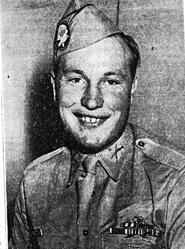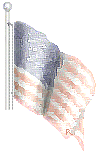NEWS FROM OUR BOYS
TO PARACHUTE TROOP
Lieut. Robert (“Bob”) Burns, son of Mr. and Mrs. J. L. Burns, 507 Otoe street, who has been stationed at Camp Wheeler, Georgia, has been transferred to Fort Benning, Georgia, to take a six-week refresher course before joining the parachute troops. Burns starred in athletics at Central high school and at the University of South Dakota and was a member of several of The Journal Golden Gloves teams.
Source: The Sioux City Journal, August 4, 1942
![]()
Veteran of Famous Airborne Unit Tells of Normandy, Arnhem and Bastogne
Veteran of 46 parachute jumps, three of which landed him in apparently hopeless positions behind the German lines in Europe, First Lt. Robert G. Burns now feels that he has had enough jumping and fighting.
“It will be all right with me if I don’t even take an airplane ride for awhile,” states the former member of the famous 101st Screaming Eagle airborne division. The story of his experiences was elicited from him somewhat reluctantly under pressure of persistent questioning by this interviewer. (The interviewer was Neil Miller, Sunday Journal Writer.)
Lt. Burns was one of 14 officers and 147 enlisted men who landed by parachute on the coast of Normandy to prepare the way for the Allied invasion. Their particular objective was a battery of 12 howitzers, which were firing across the channel of Dover. Putting these guns out of commission was essential to the invasion plan.
A Leap in the Dark
“It was six minutes before midnight when he jumped from transports which had carried us across the channel,” he related. “Our faces were blackened to lesson visibility. Because we didn’t know exactly how the Nazis would react to the attack, we wore bulky clothing, which was heavily impregnated against poison gas.”
The gun emplacements were protected by a concrete moat and high voltage wire. Perpendicular poles planted throughout the are brought disaster to many of the troops who attempted to land by glider.
“The heavy concrete moat was designed to hold off tank attacks,” Lt. Burns says. “The day before we landed, allied airmen blasted several holes in the moat. We came down with grappling hooks, which helped some of the men over the wall. Some landed inside the gun emplacement.
Germans Taken by Surprise.
“The Germans were taken by surprise, although they informed us later that we had been expected the preceding day. I landed so close to a Nazi antiaircraft battery that I could hear the voices of the men and the click of machinery as they cleared a jam. It seemed funny at the time that they were shooting at allied planes overhead while we were slipping up on the ground behind them.
“Our men worked silently and swiftly. Hand grenades were lobbed into the midst of the gun crews. Other Nazis were caught in their rest quarters. One after another, the big guns were put out of action, we sent up green signal flares and the full scale invasion was on.”
Later, when the Allied drive stalled near Carentan, members of the 101st airborne division fought their way, inch by inch, to the outskirts of St. Come du Mont, and there staged the first bayonet attack of the second world war. The attack beat back German resistance and cleared the way for the allied advance, June 7.
Only Surviving Officer
Of the 14 officers and 147 men who made the midnight jump to the coast of Normandy, Lt. Burns and 36 enlisted men were the only survivors. At the end of the European campaign, it was announced that the division’s casualty list equaled 175 per cent of its original strength.
Lt. Burns made his second combat jump behind enemy lines in Holland, where the advance of the British Second army was stalled near Arnhem.
“We were at a rest camp in England when we got orders to take off,” he says. “That mission resulted in one of the most grueling experiences of all. To deceive the enemy as to our destination, we made a long flight southward over France, then back over Belgium to Holland.
“We were in the air about three hours, and tension among the men was mounting steadily. I noticed one of them in particular. He was on the verge of cracking up, and that sometimes is contagious in a group of men who are under terrific mental and nervous strain.
Death Strikes Close.
“As we neared our target, I grabbed this fellow and held him in front of me at the hatch while I waited for the pilot to give the signal to jump. A burst of flak caught us at that moment, and the man in my arms was killed. The rest of us made the jump, landing behind the German lines.”
The fight in Holland raged for three days before members of the airborne division joined British forces.
The group later was stationed in Rheims, then headquarters for the allied command, expecting to drop down somewhere in advance of Gen. Patton’s Third Army and clear away obstacles.
“We were called out and briefed four different times for that job,” Lt. Burns says. “On each occasion, by the time we were ready to take off, Patton’s forces had swept past our proposed landing area.”
A Heroic Stand
The call finally came on December 17, when the hard pressed German army suddenly staged an about face and started a breakthrough, which threatened to sweep through Luxemburg and Belgium and hurl the allied invaders back into the channel. Members of the Screaming Eagle airborne division were ordered to the vitally important communications center of Bastogne, Belgium.
“There were no planes and parachutes that time,” the lieutenant says. “We went into Bastogne in trucks before the Germans arrived. We were supposed to fight a delaying action, then retreat, but we held on instead. The Germans started another drive. Infantry and panzers crashed against our defenses at Bastogne, then swung around the city until we were completely surrounded.
“It was our commanding officer, Brig. Gen. Anthony C. McAuliffe, who gave the new famous reply of, “Nuts,” to a German suggestion that we surrender. Gen. Maxwell Taylor, top commander of the 101st, was in Washington at the time.”
Lt. Jimmy Toy Killed
Help was on the way, but it was the day after Christmas before units of the Fourth armored division battled their way into Bastogne and relieved the battered members of the airborne division. Twenty-two more days elapsed before German resistance finally was crushed out in that area. It was on the first day at Bastogne that Lt. Jimmy Toy of Sioux City was killed.
Lt. Burns received the silver star for the Holland exploit and the bronze star for the Bastogne ordeal. The Purple Heart medal also has been awarded to him twice, for wounds suffered in Normandy and Bastogne.
During the nine months he was in training in England, between spectacular and hazardous actions on the continent and after V-E day, he served as division athletic officer and trained boxing teams, which fought in England, Wales, Paris, Munich and Czechoslovakia.
Exactly one year after the initial landing in Normandy, the 101st division staged a track meet in Hitler’s hideout at Berchtesgaden.
Golden Gloves Champion
A former Central high school football star, Lt. Burns won the light heavyweight championship in the Golden Gloves tournaments here in 1941 and 1942. He was heavyweight champion at Fort Snelling, Minn., and at Charlotte, N.C., and was heavyweight runnerup in the New York Golden Gloves contest in 1943. He was captain of the University of South Dakota football team in 1942.
Lt. Burns is a native Sioux Cityan. His mother, Mrs. Magdalena Burns, lives at 507 Otoe street. His father, Joseph L. Burns, died several years ago. A brother, James Burns, now is in the airforce at Panama. The lieutenant was graduated from the University of South Dakota in 1942 with a B.S. degree in physical education. His postwar plans include a master’s degree in physical education and an assignment as football coach.
Source: The Sioux City Journal, September 20, 1945 (photo included)
![]()

